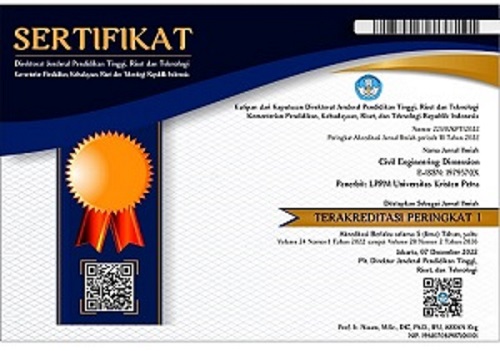Comparative Study of Conventional Rotary and Rotary-Percussion Techniques in Grout Hole Drilling from the Perspectives of Time, Cost, and Quality
 :
:
https://doi.org/10.9744/ced.25.2.115-125
Keywords:
Drilling work, conventional rotary, rotary-percussion, time, cost, qualityAbstract
A dam foundation structure is usually strengthened by grouting, which begins with grout hole drilling. This paper aims to examine a comparison between conventional rotary and rotary-percussion drilling techniques in a drilling case study of the Tugu Dam Project, from the perspective of time, cost, and quality comprehensively. Primary data was obtained from the field investigation and interviews. Secondary data was gathered from available project documents of the PT Wijaya Karya-APTA KSO Project Contractor. The findings have highlighted that the implementation of the rotary-percussion technique for grout hole drilling is better than conventional rotary drilling. There are 16 days of time-saving and 3.84% cost-savings for the rotary-percussion technique, as a result of faster rate of penetration. The quality of grouting work using the rotary-percussion drilling technique tends to be of better quality, although there is a shortcoming due to the limited drilling depth of only 5m particularly.
References
Chalermpornchai, T., Kunsuwan, B., and Mairing, W., Simulation of Rock Crack and Permeability in Dam Foundation During Hydraulic Fracturing, International Journal of GEOMATE, 21(86), 2021, pp. 55–62.
Ren, S., Zhao, Y., Liao, J., Liu, Q., and Li, Y., Lugeon Test and Grouting Application Research Based on RQD of Grouting Sections, Sustainability, 14, 2022, pp. 12748.
Direktorat Sungai Danau dan Waduk, Grouting Guidelines for Dams, Jakarta: Direktorat Jenderal Sumber Daya Air, 2005.
Purba, D., Adityatama, D., Agustion, V., Fininda, F., Alamsyah, D., and Muhammad, F., Geothermal Drilling Cost Optimization in Indonesia, 45th Workshop on Geothermal Reservoir Engineering, Stanford California: Stanford University, 2020, pp. 1–14.
Quinones-Rozo, C., Lugeon Test Interpretation, Revisited, Collaborative Management of Integrated Watersheds, Westminster Colorado: United States Society on Dams, 2019, pp. 405–414.
Asy’ari, M.A., Hidayatullah, R., Lestari, D., Kahar, S.B., and Kristiyono, M., The Effect of Grouting on the Lugeon Value of the Foundation Rocks of Tapin Dam, Jurnal Gradasi Teknik Sipil, 5(2), 2021, pp. 103–116.
Udiana, I.M., Design of Cement and Water Mixture in the Grouting Work of the Nipah Madura Dam/Reservoir Project, East Java, Jurnal Teknik Sipil, 2(3), 2013, pp. 93–104.
Jimoh, R., Sani, M., Adoza, A., and Yahaya, I., Managing Pre-Construction and Construction Risks on Project Sites in Abuja-Nigeria, Civil Engineering Dimension, 18(1), 2016, pp. 1–7.
Kumar, V.M., Wilfred, A., and Sridevi, Comparative Study of Time-Cost Optimization, International Journal of Civil Engineering and Technology, 8(4), 2017, pp. 659–663.
Direktorat_Jenderal_Sumber_Daya_Air, The Strategic Plan 2020-2024 Direktorat Jenderal Sumber Daya Air Kementrian PUPR, Jakarta: Direktorat Jenderal Sumber Daya Air, 2020.
Supratman, Anshariah, and Bakri, H., Productivity of Drilling Machine Performance in Making Blast Holes in B6 Limestone Quarry, Pangkep Regency, South Sulawesi Province, Jurnal Geomine, 5(2), 2017, pp. 59–62.
Meftah, M. Ben, Baili, M., Gassara, B., Dessein, G., and Sai, W.B., Prehole Diameter Optimization in High Speed Drilling Considering Machining Cost, International Journal of Advances Manufacturing Technology, 103(9), 2019, pp. 3323–3336.
Seetharaman, Construction Engineering and Management. Delhi: UMESH Publications, 2015.
Gambar, O.M., Rotary Drilling Process – Equipment and Procedure, Mosul Iraq: University of Mosul.
Sliwa, A.S., Wisniowski, R., Korzec, M., Gajdosz, A., and Sliwa, T., Rotary - Percussion Drilling Method-Historical Review and Current Possibilities of Application, AGH Drilling, Oil, Gas, 32(2), 2015, pp. 313–323.
Downloads
Published
How to Cite
Issue
Section
License
Copyright (c) 2023 Setya Winarno

This work is licensed under a Creative Commons Attribution 4.0 International License.
Authors who publish with this journal agree to the following terms:- Authors retain the copyright and publishing right, and grant the journal right of first publication with the work simultaneously licensed under a Creative Commons Attribution License that allows others to share the work with an acknowledgement of the work's authorship and initial publication in this journal.
- Authors are able to enter into separate, additional contractual arrangements for the non-exclusive distribution of the journal's published version of the work (e.g., post it to an institutional repository or publish it in a book), with an acknowledgement of its initial publication in this journal.
- Authors are permitted and encouraged to post their work online (e.g., in institutional repositories or on their website) followingthe publication of the article, as it can lead to productive exchanges, as well as earlier and greater citation of published work (See The Effect of Open Access).

















